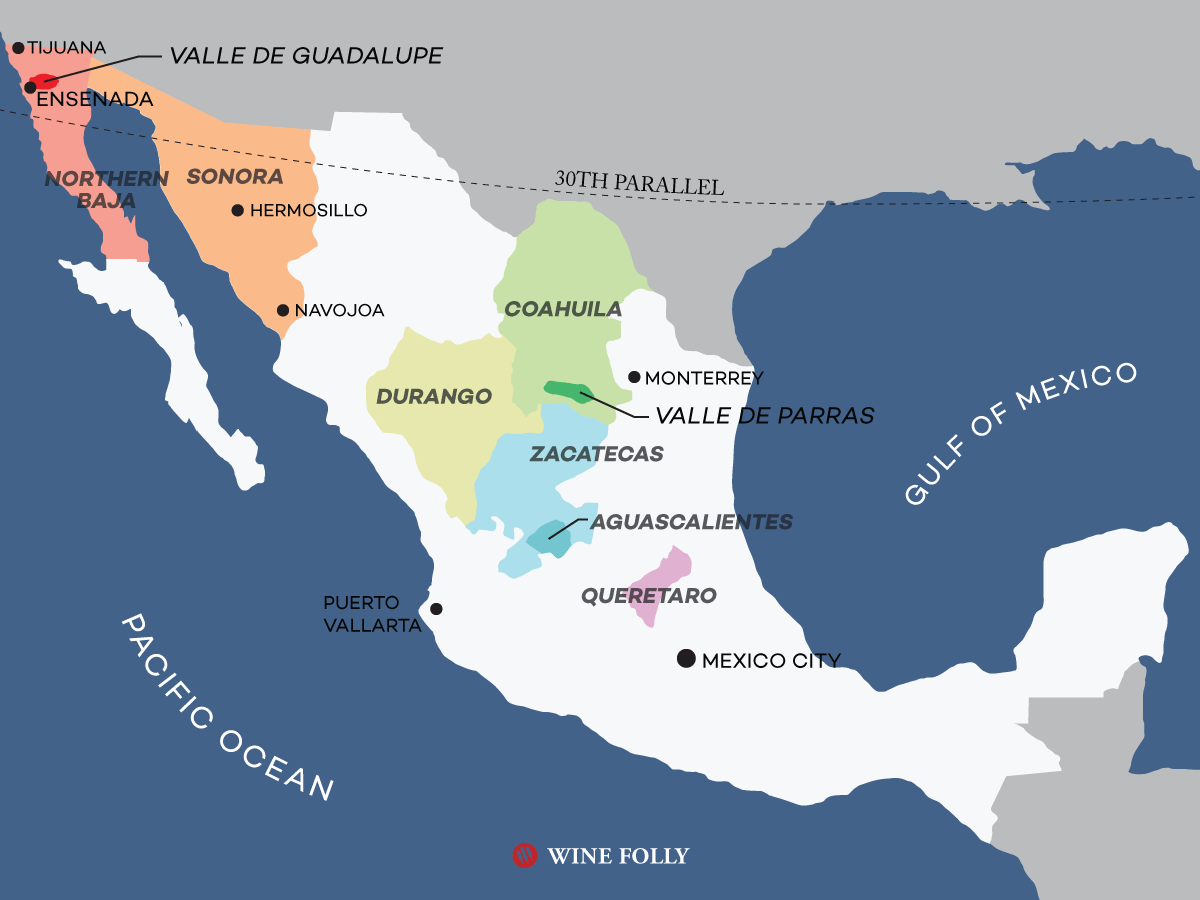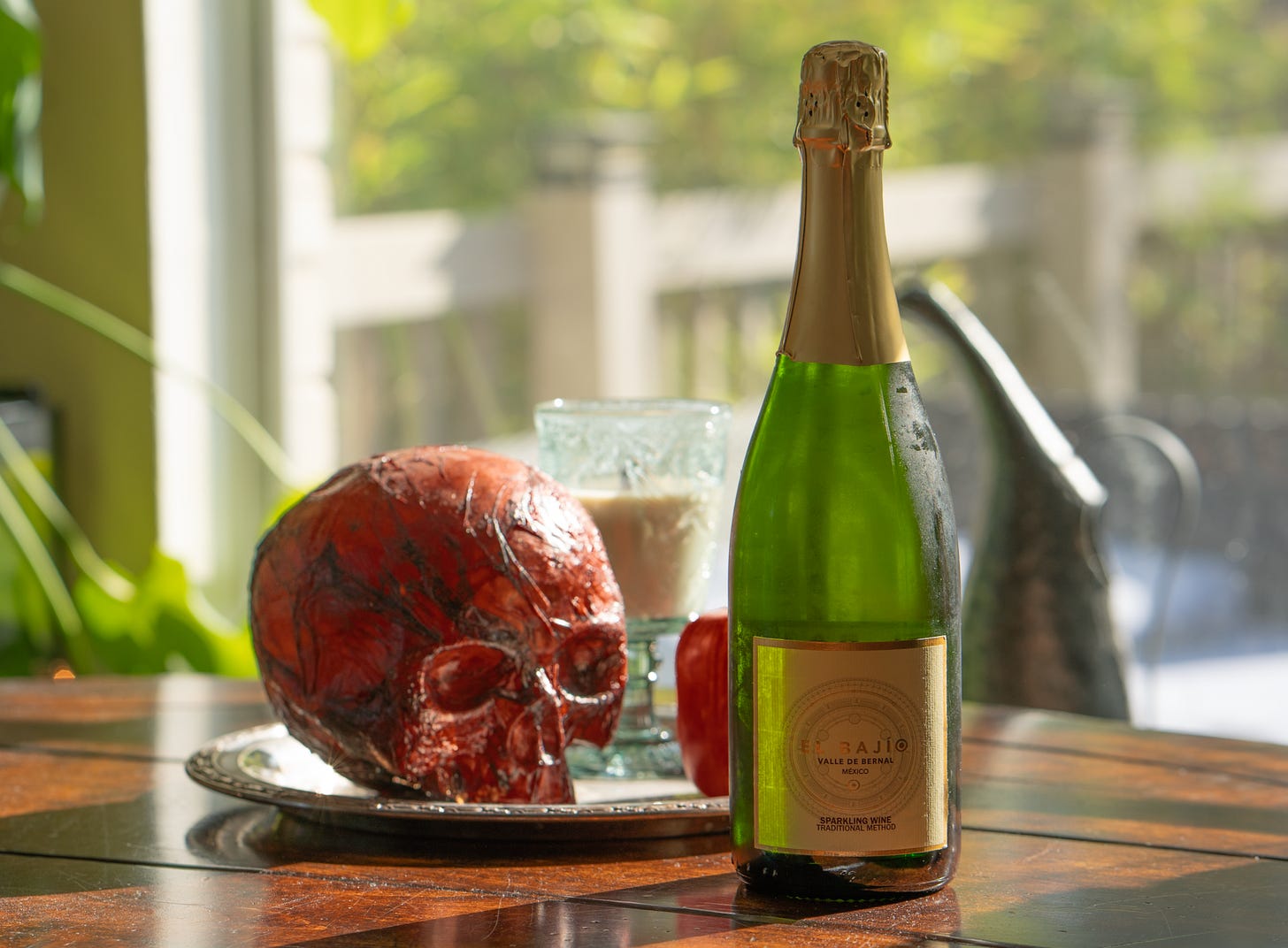Tannic Panic! Issue #127: Méthode Mariachi - Mexican Sparkling Wine
Traditional method sparkling from an unexpected place - Central Mexico
When it comes to consumables, Mexico is more immediately recognized for its food, fructose-free Coke (THE GOOD KIND), and tequila. But believe it or not, Mexico is the oldest wine-producing nation in the Americas (though the United States, Chile and Argentina tend to dominate “the conversation”) and produces a diverse range of wines, including premium bottles that contend with the best of them.
So with Dia de los Muertos just around the corner, “we” figured, what better time to pay Mexico a “little visit,” and shine a much-deserved “neon light” on a wine-producing country that is too often overlooked (LIKE ME).
HOW DID WE GET “HERE”?
Extremely “generous” Spanish colonists introduced Vitis vinifera grapevines to Mexico in the 1520s, only a few years after the conquest of the proverbial Aztec Empire. Hernán Cortés angrily ordered settlers to plant vineyards to supply wine for “Mass” (and his own insatiable gullet), and by the late 1520s, viticulture was well underway in central Mexico. Casa Madero, founded in 1597 in Parras de la Fuente, Coahuila, stands as the oldest winery in the Americas still in operation today.
DID YOU KNOW… Mexico was the first country to produce wine in the Americas – Chile and Peru didn’t start producing wine until the 1550s, Argentina followed in the 1560s, and California’s “serious viticultural efforts” only began with Franciscan missions in the late 18th century.
In spite of its so-called “beginnings” in Central Mexico, today the Valle de Guadalupe in Baja “California” (aka the “Napa of Mexico” aka “the land of jorts and bebidas” aka “Baja California”) is Mexico’s wine heartland, producing ~90% of the country’s wine. It sports a good old-fashioned Mediterranean climate with ocean cooling influence and humble granite soils that “encourage” expressive Cabernet, Syrah, Merlot, Tempranillo, Grenache, and Nebbiolo (to name a “few”).
The Valle de Guadalupe merits its own full post in the future, so we won’t bog this one down too much, but we can’t talk about Mexican wine in the modern context without mentioning this prolific “valley.”

As we move inland towards the so-called “meat” of the country, the aforementioned Valle de Parras in Coahuila is a source of ripe yet structured reds, while Querétaro’s cool highlands specialize in traditional method sparkling wines using a combination of classic Cava grapes (e.g., Xarel-lo, Macabeo) and some less conventional varieties like Ugni Blanc (often used in Loire Valley sparkling wines).
As a testament to the quality of wine being produced in Central Mexico, the Don Leo Gran Reserva Cabernet won the proverbial “trophy” (THE FIRST PLACE KIND!) for Best Cabernet Sauvignon in the Concours International des Cabernets (CIDC), beating out competitors from 24 other countries, including “fan favorites” such as “France,” “USA,” “Chile” and “South Africa.” As of 2025, the Mexican “wine industry” is worth $4.4 billion USD (UNLIKE ME), with exports led by Baja and Coahuila.
Due to the far smaller percentage of exports coming from Mexican regions outside of the Valle de Guadalupe, it’s much more difficult to track down examples to try here in the United States. But boy oh boy were we jumping loose of our drinking jorts when we saw that a bottle of traditional method sparkling from Queretaro was available at our local wine store. Needless to say, we’ve given it a gander here today.
Let’s dive into the juice.
… AND NOW FOR THE REVIEW:
Profile: Toasted almond, ripe golden pear, apple, black tea, dandelion, lemon rind
Palate: Dry, medium+ acid, medium body, long finishBlend: 50% Macabeo, 40% Xarel-lo and 10% Ugni Blanc
Quite an interesting wine with concentrated flavors that developed in the glass. It “sported” gentler bubbles than expected which dissipated relatively quickly (though I’ll note I drank this from a standard wine glass and not a flute, which expedites this process). Not too much in the way of lees flavors. Initial aromas are toasted almond and ripe pear and apple. A subtle vegetal floral aroma, like dandelion with a touch of hay, along with lemon peel add some layers. Notable black tea flavor lends a slight bitterness that helps balance out the ripeness of the fruit. I would have preferred a touch more acidity to brighten everything up and a livelier mousse, but this is an intriguing wine worth trying. It’s only one data point, but the tea component carves it a niche independent from the traditional Cava style, and it is far less lees-influenced in flavor than most of the old world traditional method sparkling I’ve tasted. This has certainly piqued my interest, so as hopefully more sparkling from Central Mexico makes its merry little way north across the border, I’ll be here, eagerly awaiting my next chance to wrap my grubby little mitts around them.
Additional deets about the winemaking & producer (source):
Winemaker is Lluis Raventós Llopart.
Grapes come from Bernal Valley in Querétaro, North-Central Mexico.
Traditional method sparkling; undergoes secondary fermentation in the bottle and is aged 18–24 months on the lees.
Dosage of 5.3 g/L and an alcohol level of 11.5%.
The producer, El Bajío, is a collaboration between La Competencia Imports and Freixenet de Mexico, created for the U.S. market. Their lineup includes two sparkling wines (Brut and Brut Rosé) and two value still wines (Marselan red and Viognier white).
Well if you weren’t convinced before, let us informulate you of your new “job” this week: head on down to the store, procure some Mexican Zeus juice (the sparkling kind) and have a little “fiesta” in your flute.
Don’t be an aguafiestas: drink Mexican wine.™
Until next time, HAPPY DRINKING PEOPLE.
Cheers!
Isaac & Zach






